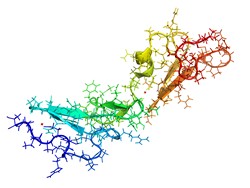Protein structure and glycosylation
Glycosylation is known for its role in protein folding, maturation, trafficking and secretion as well as function. The addition of a glycan precursor takes place initially in the endoplasmic reticulum and subsequently in the Golgi complex, where the modification is further matured by the addition of various sugar motifs. Eventually, this leads to a large heterogeneity of glycan structures not only at the organism, cell and protein levels, but also at the site of glycosylation. Apart from biological significance, this heterogeneity has broad implications for the production of pharmaceutical compounds with specific and reproducible glycan biodiversity. Understanding the role of the different glycan structures would help to reduce the glycan heterogeneity of recombinant proteins. To address this, the EU-funded GLYCAN HETEROGENEITY (Influence of the protein sequence and structure on the glycan micro-heterogeneity) project set out to investigate how the interaction between the protein and the glycan influenced glycan heterogeneity. They studied a model glycoprotein with five sites of glycosylation using classic biochemical and molecular biology approaches in combination with high-performance mass spectrometry. Results showed that each of the five sites had a specific glycan profile, with site 4 presenting the least processed glycan structure. Scientists determined the most likely path followed for the processing of each site and calculated the enzymatic conversion rate, identifying potential bottlenecks in the process. Their findings indicated that the glycan on site 4 interacted strongly with a specific amino acid in the protein surface and prevented modifying enzymes to access the glycan. Mutation of this amino acid drastically shifted the profile to highly processed glycans, demonstrating the possibility to modify the glycosylation profile through a single point mutation of the protein. Collectively, these results show that the protein structure influences glycan processing not only through steric hindrance, but also through direct interaction of specific amino acids with the glycan structure. This suggests that modification of the protein sequence might be an alternative approach for recombinant glycoprotein production at the industrial level.







